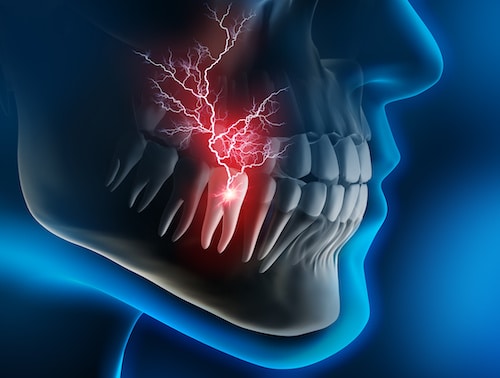Serving Henderson & Las Vegas, NV

All You Need to Know About Root Canals
Whenever the words “root canals” are mentioned, they tend to elicit a variety of emotions. For some, it’s a necessary dental procedure that brings relief from intense pain, while for others, it’s an anxiety-ridden ordeal to be avoided at all costs. Yet, amidst the myths and misconceptions, one truth stands out — root canal therapy has advanced significantly, offering a comfortable and vital solution for saving damaged teeth.
Root Canal Treatment
Root canal treatment is a dental procedure that removes infected or damaged tissue from the inside of a tooth. Root canals are an important treatment for both preserving oral health and preventing the spread of infections that could lead to tooth loss and other health issues.
What are Root Canals?
Root canals are the naturally occurring anatomic space within the roots of the teeth. These canals are filled with a soft dental pulp consisting of nerves, blood vessels, and connective tissue, which aids in the development of the root and nourishment of the tooth. When the dental pulp becomes inflamed or infected, it can cause severe pain and can lead to an abscess or systemic infection.
The Evolution of Root Canal Therapy
Once considered an uncomfortable dental procedure, root canal therapy has undergone significant evolution. Modern anesthetics and techniques make it more akin to receiving a typical filling. With precision instruments and advancements in dental imaging, dentists can now perform root canals with greater efficiency and success rates.
Do You Need a Root Canal? Recognizing the Signs
Identifying the need for a root canal begins with recognizing the symptoms that may indicate an issue with your tooth. Some of the symptoms associated with the need for a root canal include severe toothache, sensitivity to hot and cold, teeth that are changing color, swollen or tender gums, and chipped or cracked teeth. Many times an X-ray will need to be taken to confirm the need for a root canal. As with any dental pain, consider a visit to your trusted dentist. Your dentist can assess the pain in your mouth and provide you with a diagnosis and your options.
The Root Canal Procedure Explained
Contrary to popular belief, root canals do not necessarily require multiple appointments or induce severe discomfort. Here are the steps of a root canal procedure.
Step 1: Diagnosis and Treatment Planning
Your dentist will review your symptoms and perform tests, including X-rays, to diagnose the extent of the infection. If the root canal is the best course of action, the next step is to schedule the procedure.
Step 2: Anesthesia and Isolation
On the day of the root canal, your dentist will administer a local anesthetic to numb the area around the tooth. The tooth is then isolated to keep it clean and dry during the procedure.
Step 3: Access and Cleaning of the Canals
A small access hole is then drilled into the tooth, and the dentist uses special instruments to remove the infected pulp, clean the root canals, and shape them for filling.
Step 4: Filling the Canals
The cleaned canals are filled with a bio-compatible material called gutta-percha. This seals the canals to prevent recontamination and promotes healing.
Step 5: Restoring the Tooth
After the canals are filled, a temporary or permanent filling material is placed in the access opening to seal it. The tooth may also require a crown or a restoration, especially if it’s a back tooth, to protect it and restore it to full function.
Common Misconceptions About Root Canals
Root canals have their fair share of myths attached to them, which can lead to anxiety and avoidance. Here are some of the most persistent misconceptions debunked:
Myth 1: Root Canals Are Painful
Thanks to modern anesthetics, most patients report that the procedure feels no different than getting a standard filling. Any discomfort after a root canal can usually be managed with over-the-counter pain medications.
Myth 2: Root Canals Cause Illness
The myth that root canals can lead to illness or diseases elsewhere in the body has been extensively debunked. There’s no scientific evidence to support this claim, and, in fact, a root canal can save your tooth and your health.
Myth 3: Extraction Is Always the Better Option
Saving your natural tooth should be your first choice whenever possible. An extracted tooth must be replaced with a dental implant or bridge, which can be more costly and time-consuming than a root canal.
After the Procedure: Recovery and Maintenance
Understanding the recovery process and post-procedural care can alleviate any concerns you might have about your root canal.
Recovery Timeline
- The vast majority of patients can resume their normal activities the next day after a root canal.
- It’s common to experience some mild discomfort in the treated area for a few days, which can be managed with pain relievers.
Long-Term Maintenance
- Practice good oral hygiene, including regular brushing, flossing, and dental visits, to prevent future infections.
- For the best outcomes, avoid chewing on the treated tooth until your dentist has restored it with a crown or other restoration.
The duration of a root canal can vary, but most procedures are completed in one to two hours. Complicated cases may require additional visits or an endodontist’s expertise.
The Root Canal’s Vindication
Root canals are not the dental demon they’re sometimes portrayed to be. They are precise, pain-relieving procedures tailored to save your natural teeth and protect your overall oral health. Despite the myths and misconceptions surrounding them, root canals have a high success rate and can last a lifetime with proper care.
It’s important to consult with your dentist if you’re experiencing tooth pain or discomfort, as early intervention can prevent more serious issues down the line. Understanding the facts about root canals can pave the way for a less stressful and more effective dental care experience. Our office in Henderson is always available for more information regarding root canal treatment.


